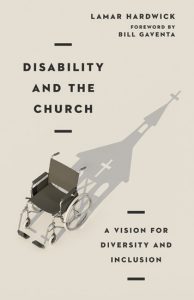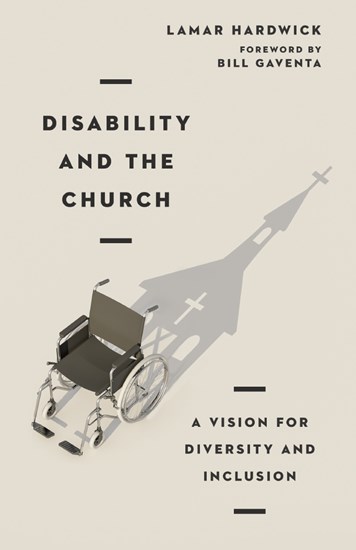Hardwick, Lamar. Disability and The Church: A Vision for Diversity and Inclusion. Downers Grove: InterVarsity Press, 2021, pp. 199, $12.99, paperback.
Lamar Hardwick, known as “the autism pastor,” is a strong advocate for people with disabilities. Hardwick is the lead pastor of at Tri-Cities Church in East Point, GA and the author of Epic Church and I Am Strong: The Life and Journey of an Autistic Pastor. Lamar has not always had his current reputation as “the autism pastor.” For many years, Lamar struggled with interpersonal relationships and social anxiety. At the age of thirty-six, doctors diagnosed Hardwick with Autism Spectrum Disorder (ASD).
In Disability and the Church, Hardwick includes eight chapters devoted to creating an inviting atmosphere for people struggling with a disability. According to Hardwick, the disabled community is the largest minority in the world (p. 12). For Hardwick, many churches are failing at their responsibility to be an inclusive Christian institution. Hardwick explores various avenues through which the church should implement diversity and disability strategies in the body of Christ. If the church wants to make a kingdom impact, Christians must recapture God’s intent of inclusion and access into God’s kingdom (p. 18).
In the opening chapter, Hardwick confronts the set of circumstances that keeps the church from ministering to the disabled community. Due to sin, the church struggles with diversity. Pastors and congregation members must realize that making disciples means creating a culture of diversity (p. 39). Another hindrance regarding diversity is the issue of outward appearance. Hardwick makes a strong indictment that some churches do not value the disabled because of pride (58). Hardwick uses Jesus’ teaching of the wedding banquet (Luke 14:8) to challenge contemporary culture to rethink symbols of power and prestige. The church acts in a prideful manner when it places more value on the able-bodied rather than on those with disabilities.
If churches want to have strong and vibrant ministries regarding the disabled community, the leadership of the church must teach and foster a culture of including people with disabilities. Therefore, the church must change their theology and structure regarding disabilities. Pastors and congregation members must discuss issues relating to the disabled community, and change church policies, processes, and programs that might restrict fruitful church membership (p. 99).
After mentioning the hindrances to diversity and inclusivity, Hardwick spends three chapters devoted to changing the church culture and its relationship to the disabled. First, churches must create a learning culture that focuses on the experience of people with disabilities. Hardwick asserts that preaching is the primary tool for building a learning culture (p. 112). Second, churches must build a linking culture that provides a root system for families with special needs and disabilities. Small groups, community groups, and a personal invitation to church are great ways to establish a viable rooting system that attracts families to the local church (136-137). Finally, churches must build a leadership culture that supports disabled persons. According to Hardwick, creating a leadership culture that supports disabled person in leadership begins with examining and removing the barriers to leadership in the church (p. 150).
In the final two chapters, Hardwick calls for churches to synchronize with heaven. In other words, churches must cast a compelling vision of church life which includes persons with disabilities and special needs (p. 164). If churches want to have meaningful kingdom impact, pastors and church members must affirm the disabled by giving them leadership opportunities and responsibilities that matter (p. 176). For Hardwick, the church must learn how to do ministry with persons with disabilities rather than doing ministry for persons with disabilities (pp. 189-190).
In chapter five, Hardwick makes a strong assertion that the Apostle Paul had a disability according to Galatians 4:12-13 (pp. 110-111). As a student of biblical and theological studies, this reviewer had a hard time understanding Hardwick’s broad use of labeling certain biblical persons with a disability. For instance. This reviewer believes that Hardwick’s assessment makes too quick of a theological leap from Paul’s personal situation to a disability. The Bible does not provide the exact nature of Paul’s illness. While a certain illness or malady may have hindered Paul from traveling at the time, the illness did not totally hinder the Apostle from all travel or future ministry.
For churches that struggle with diversity and inclusion, there are three reasons why pastors and congregation members should read Hardwick’s book. First, Hardwick provides his readers with encouragement and motivation to change the existing church culture. While there are parts of the book that focus on negative aspects of church life and ministry, Hardwick devotes much of his writing to positive words of encouragement and motivation. Churches often struggle with change and implementing new ministry strategies, but this volume provides readers with the theological resources to motivate change within the church. Ultimately, the church should include persons with disabilities because God’s kingdom includes persons with disabilities.
Second, pastors and teachers within the church can find practical resources for implementing a church culture that includes persons with disabilities. The first practical tool for changing the church culture is a vibrant preaching ministry. This reviewer believes that Hardwick is right when he states that preaching is the primary tool for building a culture that includes the disabled community. The first step in changing the church culture involves teaching the church about what God requires regarding the church’s relationship and responsibility to persons with disabilities.
The second practical tool for changing the church culture concerns the structure of the church’s discipleship ministry. Churches should implement small groups or community groups that include the disabled community. Small groups and community groups could act as a safe environment which provides comfort and care for persons with disabilities and their caregivers. Also, small groups and community groups provide a safe environment for the disabled community to voice their concerns regarding ministry opportunities within the local church.
Third, pastors and church members should read Hardwick’s book because of its unique characteristic. First, Hardwick’s book is unique because there are not a lot of books regarding persons with disabilities. Second, Hardwick’s book is unique because he struggles with a disability. Therefore, pastors and lay leaders can get a better understanding of the disabled community because Hardwick’s book focuses on the church and his experience as a pastor with autism.
Hardwick’s book is right on cue regarding the current topics of inclusion and diversity. Pastors, lay leaders, and church members should read Disability and the Church if interested in developing a ministry of inclusion regarding persons with disabilities. Disability and the Church is a relatively easy book to read for the active pastor or lay leader. Therefore, it is possible to make Hardwick’s book a primer regarding the church’s ministry to persons with disabilities. Once the church has fully embraced the inclusion of the disabled community, pastors and lay leaders can finally do meaningful ministry with persons with disabilities rather than doing ministry for persons with disabilities.
Dr. Matt Martin
First Baptist Church Natchez, MS





